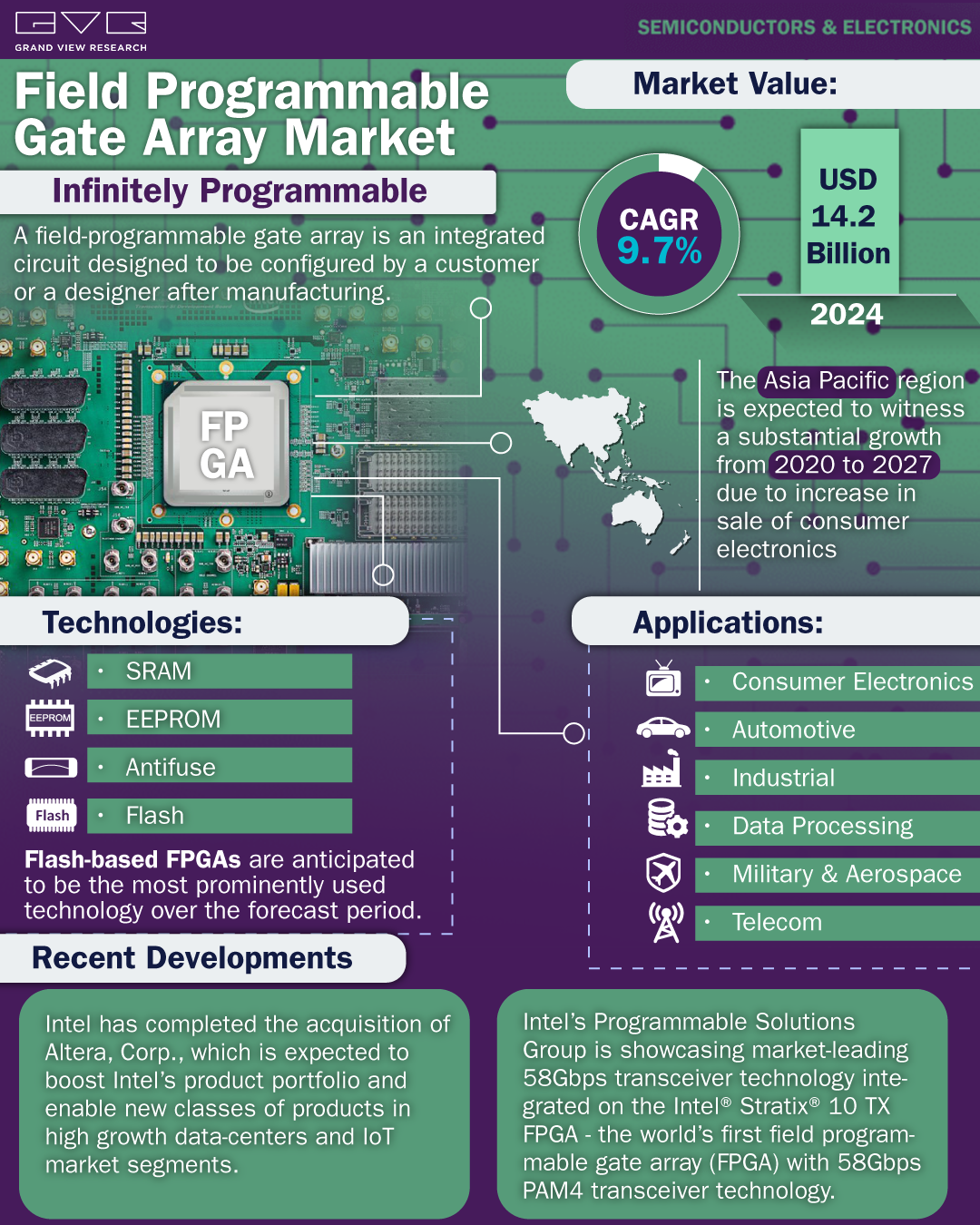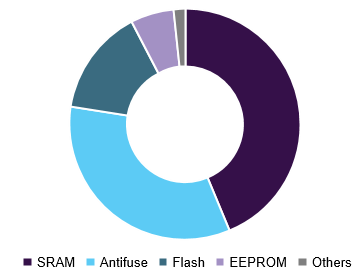Field Programmable Gate Array Market - Cruising Ahead
When we go through well-known acronyms starting with F, such as FIFA, FAO, FBI among others, FPGA might not come up (unless you’re a tech geek). However, we are surrounded with it and our appliances would find it extremely difficult to function without it.

All About FPGA & More…
The Field Programmable Gate Array is an Integrated Circuit (IC) which can be configured to a device by a customer after its manufacturing, hence it is termed as - Field Programmable. Some FPGAs can be reprogrammed infinite times and some limited times. Hardware Descriptive Language (HDL) is used to configure FPGA, in a manner similar to the configuration of application-specific integrated circuit (ASIC). In general terms, FPGAs are programmable silicon chips with a collection of programmable logic blocks surrounded by Input/Output blocks that are put together through programmable interconnect resources to become any kind of digital circuit or system.
FPGAs are more reliable than the microprocessors, as they are truly parallel in nature. Each independent task is assigned to the dedicated section on the chip. Therefore, performance of one section is not affected by the other section.
The unique feature of FPGAs to be reprogrammed post manufacturing for fulfilling a specific task makes them beneficial for users. Over the past few years, usage of FPGAs has increased from high-end devices to mid-end and low-end design needs across industries. With FPGAs, device engineering and prototyping is possible in a much lesser time and cost as compared to the traditional ICs. These usages propel the demand of FPGA, in fact, Field Programmable Gate Array market is expected to reach USD 14.2 billion by 2024, according to a new report by Grand View Research, Inc.
Further Enhancements
Ross Freeman, cofounder of Xilinx, developed FPGA in 1985 for the first time and since then it has come a long way. Logic capacity of FPGAs increased with advancements in technology, along with the that demand for FPGAs skyrocketed, as it came to be used in diverse sectors due to its reprogrammable ability.
Types of FPGAs:
Based on programming technology, FPGAs are classified into three types -
-
SRAM-based FPGAs: Static RAM cells control pass-transistor, transmission gates, or multiplexers. They can be reprogrammed several times with evolving design, however they require an external memory to support it, as the program is lost every time it is turned off and needs to be reconfigured upon restart.
-
Antifuse-based FPGAs: It is antifuse CMOS technology enabled and can be programmed only once. It retains the program even if it is switched off and does away with the need of the external memory.
-
Flash-based FPGAs: Floating gate cells are as switches leading to improved area efficiency. They do not end up losing the program when switched off. Also, they don’t require external memory, however, they can’t be reprogrammed infinite times due to charge build up in the oxide.
In the United States, SRAM has higher demand among its other variants and dominates the market. This can be aptly understood by the pie chart below.
U.S. FPGA market, by technology, 2015 (USD Million)

Over the years, there has been a transition in the technologies used for FPGAs. Fuse and Erasable Programmable Read-Only Memory (EPROM) based FPGAs are declining to give way to improved technologies such as the Static Random Access Memory (SRAM) and antifuse-based FPGA technology.
SRAM-based FPGAs are nonvolatile, simple in designing, and consume less power. The flash-based FPGAs are nonvolatile, electrically erasable, reprogrammable, and use single and multi-level memory chip for storing information. Both SRAM and flash based FPGAs are anticipated to experience high demand in the upcoming years.
Applications In Abundance
FPGAs have varied applications across industries. They have been heavily used in the telecom industry, data processing industry, industrial sector, energy and aerospace & defense among others.
-
Telecommunications - FPGAs have multiple uses in networking and telecom sector. FPGAs allow system designers to use silicon designs that lets them implement their own designs rather than using others design which may not match their particular requirements. In 2015, the telecom industry contributed heavily to the global FPGA revenue; it is anticipated to continue being the dominant end-use sector in the upcoming years. This is attributed to the exponential increase in mobile phones and growing wireless technology worldwide.
-
Energy - Renewable energy sources are the tomorrow of energy sector. They are going to be leveraged on a larger scale by the countries. These energy sources are reliable and are found to be part of smart-grids. Efficient power supply and end-to-end communication is one of the basic requirements of the smart grid. For this reliability, FPGAs are used. It supports hardwired, real-time switch performance and reduced latencies. It meets the performance requirements of Gbps Ethernet traffic with PRP/HSR redundancy and evolving PRP/HSR standards.
-
Automotive - In the automotive industry, FPGAs have proved to be extremely efficient for digital signal processing, multi-threading, micro controlling, and parallel processing capabilities. FPGAs allow the automotive OEMs (Original Equipment Manufacturers) to develop innovative solutions and enhancements such as adaptive cruise control, collision avoidance, and blind spot warning. Apart from that, FPGA’s reliability in functioning makes them an ultimate choice for the OEMs.
-
Aerospace & Defense - FPGAs are increasingly used in military & aerospace industry for waveform generation and image processing. This sector is all about the extreme conditions that are needed to be handled. Xilinx provides rad-hard and rad-tolerant FPGAs that meet the performance, reliability, and lifecycle demands of extreme environments, while enabling greater flexibility than feasible with traditional ASIC implementations.
Also, FPGAs are used for processing-intensive space systems. These capabilities provide FPGAs an important status and increases its utility in aerospace & defense.
Use of FPGAs is further projected to grow in the consumer electronics, automotive, and military & aerospace industry. Demand for more distinguishing features by consumers in home appliances and other electronic gadgets has boosted the demand for FPGAs in the consumer electronics industry.
Market Insights
Factors such as the technological efficiency of FPGAs over the Application Specific Integrated Circuits (ASICs), its growing demand across industries, and the technological improvement of FPGA circuits have made it very popular among users. The market growth is expected to be robust in the future. However, the designing complexities of FPGA circuits and their overlapping market to some extent with System on Chips (SOCs) and ASICs may be a barrier to the otherwise growing FPGA market.
Altera and Xilinx are the two major competitors in the market and have been in operation since more than 3 decades. Both of them provide similar products and depend on innovation to gain larger market share globally. Together they hold almost 90% of the market.
Recent Developments
-
Intel completes the acquisition of Altera, corp., a leading provider of FPGA technology. This acquisition is expected to boost Intel’s product portfolio and enables new classes of products in high growth data-centers and IoT market segments.
-
Intel’s Programmable Solutions Group is showcasing market-leading 58Gbps transceiver technology integrated on the Intel® Stratix® 10 TX FPGA - the world’s first field programmable gate array (FPGA) with 58Gbps PAM4 transceiver technology.
 In-depth report on global field programmable gate array (FPGA) market by Grand View Research:
In-depth report on global field programmable gate array (FPGA) market by Grand View Research:
https://www.grandviewresearch.com/industry-analysis/fpga-market
To schedule a free market intelligence database demo, please complete the form below:
Service Guarantee
-
Insured Buying
This report has a service guarantee. We stand by our report quality.
-
Confidentiality
Your transaction & personal information is safe and secure.
-
Custom research service
Design an exclusive study to serve your research needs.
-
24/5 Research support
Get your queries resolved from an industry expert.